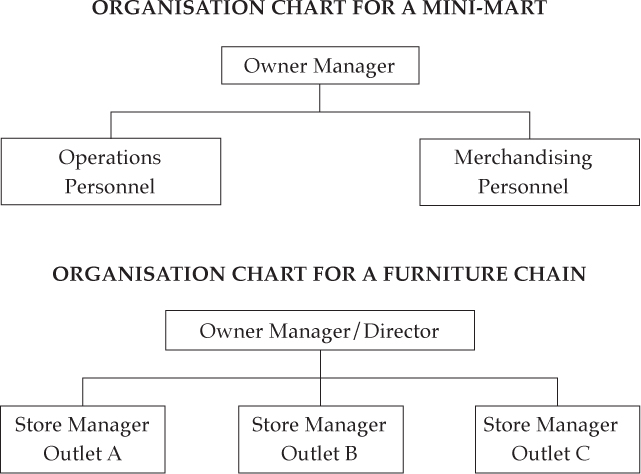Chapter 16. Organisation and People Management

A retail organisation, whether big or small, must be well-organised and the employees must be effectively managed.
Since many small retailers are mainly family-operated businesses and hire only a few workers, they tend to think that there is no need to have any organisational structure. They prefer to conduct their businesses on an informal basis, which gives rise to ill-defined roles and inappropriate practices.
At the same time, retailers often lament that staff turnover is too high and so they do not spend effort in managing their employees. There are no company policies and procedures pertaining to personnel management. This results in unmotivated workers who feel that the company does not care about their welfare, and so leave for better opportunities elsewhere.
The following discussions aim to raise awareness of issues relating to the development of organisational structure, building of company or shop culture, and management of employees, all of which are applicable to both big and small retailers.
Organisational Structure
In order to achieve co-ordination and control, a retailer has to plan for the following:
1. Identify jobs based on the following categories:
• Function (operations, buying, delivery)
• Product (gifts, ladieswear, housewares)
• Geographic (locations of outlets)
• Combination of the above
It is common for a small retailer to hire an employee who is able to multi-task; for example, the store supervisor may be incharge of operations, buying, training and coordinating delivery at the same time.
2. Develop inter-relationships among the various positions
Individual employees have their own jobs to perform, but at the same time, they need to coordinate with one another and work together to build a successful business.
3. Outline the hierarchy of authority
The reporting relationship among the employees, from the lowest to the highest level, has to be clearly defined. A small retailer usually has only two to three levels of personnel.
4. Create an organisation chart
An organisation chart graphically displays a retail organisation’s hierarchical relationships. It is useful to display the chart in the shop (perhaps at the back office) so that the employees are aware of the hierarchy of authority. The following charts show the organisations of two small retailers.

Culture Development
A retail organisation comprises employees from varied backgrounds and of different personalities. These employees have their own set of beliefs and values. How can a retail organisation develop a common identity among the employees? What should be done to create a unique image perceived by the customers? The answer lies in the development of an organisational culture.
A retail organisation, whether big or small, has to develop its own culture.
Organisational culture is similar to a person’s personality. It reflects a company’s vision and mission,
which are often created by the owner and senior management.
It is a common system of values and practice evolved in the company. It provides guidance on what can and cannot be done.
Small retailers often have the misconception that culture is sophisticated and therefore meant only for big companies. Culture can be any value and practice that a small retailer identifies as beneficial to the growth and unity of the company.
Here is an example:
A neighbourhood grocery shop may be small, but the employees have to order, receive and replenish stocks, handle the POS system, serve customers, administer delivery, supervise staff and manage the finances. The employees merely carry out their respective duties. The owner may want to introduce the following principles and values to motivate the employees to work towards a common goal:
• Honesty: Employees should deal honestly with the customers.
• Open communication: Owner and manager should communicate store policies, procedures and problems to the staff.
• Unity: Employees should not blame one another when problems arise, but should work together to resolve the issue.

• Responsibility: Every employee should complete his task within the given time,and be responsible when handling a customer’s requests.
• Punctuality: Employees should be punctual for work and respond to customers without delay.
The above values are the guiding principles for appropriate behaviours at the workplace. Both senior and junior staff should carry out the principles consistently. A particular image will evolve over time and become the culture of the shop.
The success will depend on the owner’s conviction and persistence in the implementation.
People Management
Employees carry out the operational and merchandising procedures, serve the customers and, to a certain extent, determine the image of the shop. As a small retailer, one of the most important tasks is to develop and train an effective and efficient workforce to conduct the business with good and consistent standards.
Every employee should receive the guidance, direction and support needed to perform the job productively. Suitable employees have to be recruited, trained, motivated and supervised.
At the same time, they have to be
fairly treated and compensated.
Recruiting the Potential Employee
Depending on the position, a retailer can find potential employees from the following sources:
• Educational institutions
• Competitors
• Other industries: People from another industry who possess suitable attributes and skills can be hired as they can provide fresh ideas and add value to the business.
• Employment agencies
• Recruitment advertisements
• Notices in the store: A small retailer may place notice of job vacancies outside the shop. However, such advertisements must be properly written and posted. A substandard, handwritten advertisement creates a bad impression for both the potential employee and the customers.
• Current workers: Sometimes, it is more productive to promote a current employee who is familiar with the shop procedures and culture.
• Employee referrals
Selecting the Right People

A Human Resource staff interviewing a potential employee
The retailer has to select the person who matches the job requirements and the company culture.
While the retailer is choosing suitable candidates, these candidates are also evaluating the retailer as a potential employer through the selection process. Hence, it is important that the selection process be carried out in a professional manner. Retailers can use one or a combination of the following selection methods:
1. Interview: Retailers should be prepared for the interview — questions, venue and length of interview, attributes to look out for.
2. Tests: Larger retailers may utilise aptitude and integrity tests for management and security positions. A simple mathematical test may be useful for selecting cashiers.
3. Reference checks: Some retailers contact the references either prior to or after the interview to find out more about the potential candidate.
Retailing is a service-oriented industry.
People who desire to work in the retail industry have to possess certain qualities and attributes. Sales assistants and assistant cashiers may require personality traits such as:
• Cheerfulness
• Patience
• Honesty
• Pleasant grooming
Supervisors, store managers and merchandisers will require additional attributes such as:
• Analytical skills
• Creativity
• Flexibility
• Initiative
• Leadership
• Stress tolerance

Training and Developing the Employees
Small retailers are often apprehensive about training their staff. With rapid staff turnover, many retailers feel that it is a waste of resources to train the employees. There must be a paradigm shift.
Enhancing employees’ abilities to communicate with customers, solve problems, sell the products and carry out appropriate operational procedures will help increase customer patronage and sales.
There are generally three types of training programmes.
1. Orientation programmes: When a new employee joins a retailer, he should be briefed on the company’s history, policies, working hours, medical and fringe benefits, chain of command and job responsibilities. He should be introduced to the immediate superior and colleagues. Some retailers may even assign a mentor to guide the new employee.

Training and developing employees will help to increase sales
2. General programmes: Usually, general programmes comprise training related to the development of service quality, selling techniques, leadership skills and personal attributes.
3. Specific programmes: These are job-specific training such as POS system operations, cash and credit card handling, receiving and marking procedures, buying techniques and other operations procedures.
Retailers must also determine the following issues in the training programme:
• Length of the training programme: It varies from one- or two-day sessions to two-year programmes.
• Training schedules for all the staff in a calendar year: Some skills, for example, customer service, may require more frequent training. With the increase in customers’ expectations, customer service skills must be constantly reinforced or updated.
• Training needs of staff: Retailers should identify the areas that need improvement or correction.
• Format of training: Retailers have to determine how the training should be conducted. Although training is often associated with classroom programmes, a small retailer may find the on-the-job training method more effective. The owner or manager can utilise the operational manuals to train the staff on the sales floor. In this way, staff do not need to be sent away but are still available on the sales floor to serve the customers. In addition, although programmes such as leadership skills and POS system operations may require external trainers, training related to the shop operations, communication and customer service may be conducted by the owner or the manager.
Compensating the Employees
Employees should perceive compensation as fair.
Rewards should be clearly related to the employees’ work.
If excellent service is determined as important, then the employees should be rewarded based on how well they serve the customers. At the start, retailers should determine the assessment criteria and communicate this to the employees. The following tips provide retailers with some guidelines on the determination of compensation schemes:
• Retailers should develop a pay structure for different levels of position.
• Compensation can be based on individual and/or team performance.
• Generally, compensation is based on sales and profit earned. Retailers can also base incentives on more creative criteria, such as mystery shopper scores, good customer service (the number of compliments received by an individual employee), minimal discrepancies encountered by a cashier and lowest inventory shortages.
• There are various compensation methods.
– Monetary payments such as salaries, commissions, bonuses and so on. A combination of monetary incentives may be used. For example, a ladieswear boutique may introduce a three-tier scheme — a basic salary, individual commission and a store bonus — for additional sales achieved.
– Fringe benefits such as medical reimbursement, paid vacation, insurance benefits, additional annual leave, profit sharing and so on.
Supervising the Employees
A retailer who is too concerned about checking on staff movement — what time they report to work, what time they go for their break and how long they take for their break,
is simply controlling the employees. No supervision has taken place.
The objectives of supervision are to:
• improve productivity
• maintain employee morale
• motivate staff
• communicate store policies
• resolve problems
• reduce repetitive work
• monitor expenses
Retailer’s Options
From the above discussions, we can conclude that a healthy and growing retailer with motivated staff calls for the combination of a well-organised company, a strong shared culture among the employees, and an effective and efficient human resource management process.

Get regular feedback from your staff
For retailers who have never thought of these issues, it is time to pay attention to them. The following questions may be helpful for a start:
• Does the company have a vision and mission statement? If yes, are they communicated to all the staff?
• Are the lines of authority clear?
• Do employees know their respective responsibilities?
• Are the jobs and their respective scope of duties clearly described?
• Does the company have policies with regards to recruitment, selection, training, compensation and supervision of staff?
• How does the company hire staff?
• Are the employees feeling happy and satisfied? If yes, what are the factors that contributed to their satisfaction?
